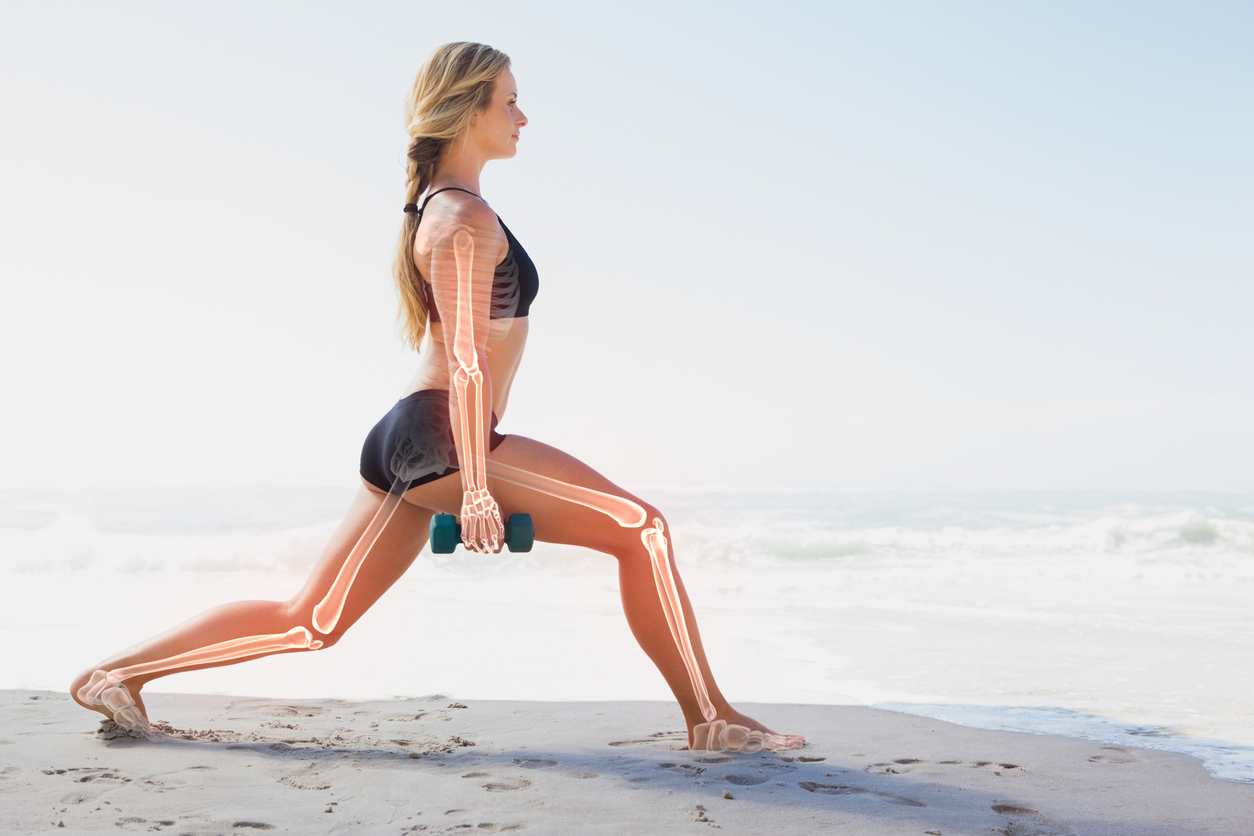Fitness and the Skeletal System

The skeletal system is a core component of the body’s support structure and permits movement, makes blood cells and provides protection to the organs. Beyond this, the skeletal system behaves as a reservoir for an array of vital minerals, including calcium and phosphate, which can be released on demand when needed in the body in order to maintain serum homeostasis (An & Martin, 2003). Therefore, any disruptions to the skeletal system can have catastrophic implications on bone health and homeostasis, resulting in conditions such as osteoporosis (Sözen et al., 2017). Regular exercise can reduce the rate of bone loss and osteoporosis, decreasing the likelihood of bone fractures and damage to the skeletal system.
It comes as no surprise that lifestyle choices have a significant impact on the development of skeletal conditions and the risk of fractures. For example, physical inactivity represents one of the largest modifiable risk factors for osteoporosis (Rogers & Hinton, 2010). Osteoporosis is defined as “low bone mass and micro-architectural deterioration of bone tissue, leading to enhanced bone fragility and a consequent increase in fracture risk” (Health & Services, 2004). In other words, osteoporosis is caused by and amplifies the weakening of the bones. Weight-bearing exercises and resistance training are crucial in improving bone density and helping to prevent this skeletal impairment and are one of the primary routes of prevention and treatment.
In patients with osteoporosis, a large amount of research has been conducted to investigate the effectiveness of physical exercise as a treatment. A 2018 study reviewed the current literature on this topic, with weight-bearing aerobic exercises and strength and resistance exercises emerging as two core activities for alleviating osteoporotic symptoms. Weight-bearing aerobic exercises included walking, stair climbing, jogging, and Tai Chai, to name a few, while strength and resistance exercises included lifting weights, swimming, and cycling. Multicomponent exercises also demonstrated great promise and consisted of a combination of fitness activities, including aerobics, strengthening, progressive resistance, balancing, and dancing. These fitness regimes are particularly popular amongst elderly persons that are not able to regularly perform resistance or weight-bearing activities (Benedetti et al., 2018).
The importance of fitness on skeletal system health was highlighted by the American College of Sports Medicine in their recommendation that weight-bearing endurance activities be carried out at least three times a week and resistance exercise at least two times per week during adulthood to preserve bone health (Kohrt et al., 2004). Several studies have explored the impact of persistent exercise during young adulthood, noting that the benefits of these activities, including increased bone mineral density, carry through to adulthood. Additionally, bone loading through regular physical activity during adulthood substantially increases bone size, cortical area and strength and significantly reduce the risk of hip fractures later in life(Daly & Bass, 2006; Michaëlsson et al., 2007).
How does exercise impact the skeletal system? The current literature proposes that physical fitness affects the bone structure through several mechanisms, specifically muscle contraction forces, gravitational loading, and endocrine/paracrine effects. When engaging in physical activity, mechanical forces are exerted on the bone via muscle contraction and gravitational loading. The bone cells (osteocytes) perceive these forces as cell deformation and induce changes in the extracellular fluid, pressure gradients, and electric fields. Bone formation and resorption are modulated as a result, changing the bones’ geometry and material properties (Robling et al., 2006; Turner & Robling, 2005).
Simply stated, physical activity improves skeletal system health by increasing or preserving bone mass. In turn, this prevents the deterioration of the skeletal structures and reduces the risk of developing debilitating conditions, such as osteoporosis. Although the current literature recommends differing levels of daily exercise, weight-bearing endurance activities and resistance exercises should be carried out a minimum of three times per week. This may involve swimming, cycling, or a fast-paced walk. Committing to physical fitness can have profound benefits later in life and ensures the risk of skeletal system deterioration is substantially reduced.
Dan Tatro-M.S.-CSCS
CEO – OC FITNESS COACH
REFERENCES
An, Y. H., & Martin, K. L. (2003). Handbook of histology methods for bone and cartilage. Springer.
Benedetti, M. G., Furlini, G., Zati, A., & Letizia Mauro, G. (2018). The Effectiveness of Physical Exercise on Bone Density in Osteoporotic Patients. Biomed Res Int, 2018, 4840531. https://doi.org/10.1155/2018/4840531
Daly, R. M., & Bass, S. L. (2006). Lifetime sport and leisure activity participation is associated with greater bone size, quality and strength in older men. Osteoporos Int, 17(8), 1258-1267. https://doi.org/10.1007/s00198-006-0114-1
Health, U. D. o., & Services, H. (2004). Bone health and osteoporosis: a report of the Surgeon General. Rockville, MD: US Department of Health and Human Services, Office of the Surgeon General, 87.
Kohrt, W. M., Bloomfield, S. A., Little, K. D., Nelson, M. E., & Yingling, V. R. (2004). American College of Sports Medicine Position Stand: physical activity and bone health. Med Sci Sports Exerc, 36(11), 1985-1996. https://doi.org/10.1249/01.mss.0000142662.21767.58
Michaëlsson, K., Olofsson, H., Jensevik, K., Larsson, S., Mallmin, H., Berglund, L., Vessby, B., & Melhus, H. (2007). Leisure physical activity and the risk of fracture in men. PLoS Med, 4(6), e199. https://doi.org/10.1371/journal.pmed.0040199
Robling, A. G., Castillo, A. B., & Turner, C. H. (2006). Biomechanical and molecular regulation of bone remodeling. Annu Rev Biomed Eng, 8, 455-498. https://doi.org/10.1146/annurev.bioeng.8.061505.095721
Rogers, R. S., & Hinton, P. S. (2010). Bone loading during young adulthood predicts bone mineral density in physically active, middle-aged men. Phys Sportsmed, 38(2), 146-155. https://doi.org/10.3810/psm.2010.06.1793
Sözen, T., Özışık, L., & Başaran, N. (2017). An overview and management of osteoporosis. Eur J Rheumatol, 4(1), 46-56. https://doi.org/10.5152/eurjrheum.2016.048
Turner, C. H., & Robling, A. G. (2005). Mechanisms by which exercise improves bone strength. J Bone Miner Metab, 23 Suppl, 16-22. https://doi.org/10.1007/bf03026318



